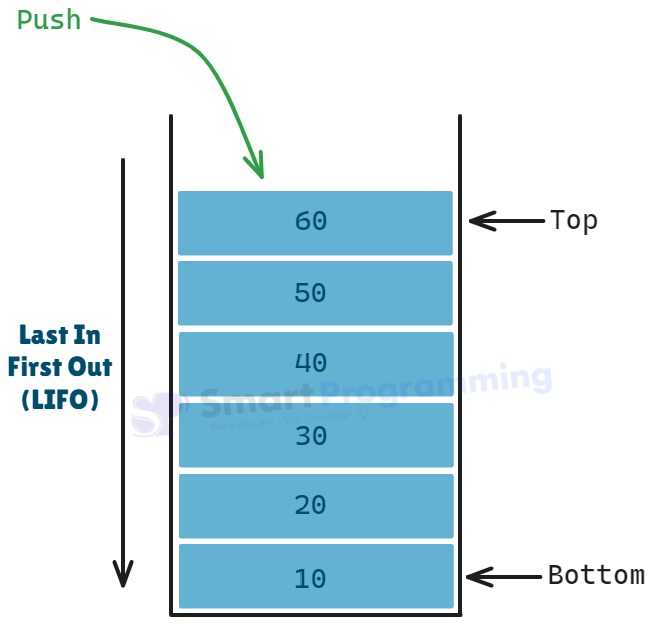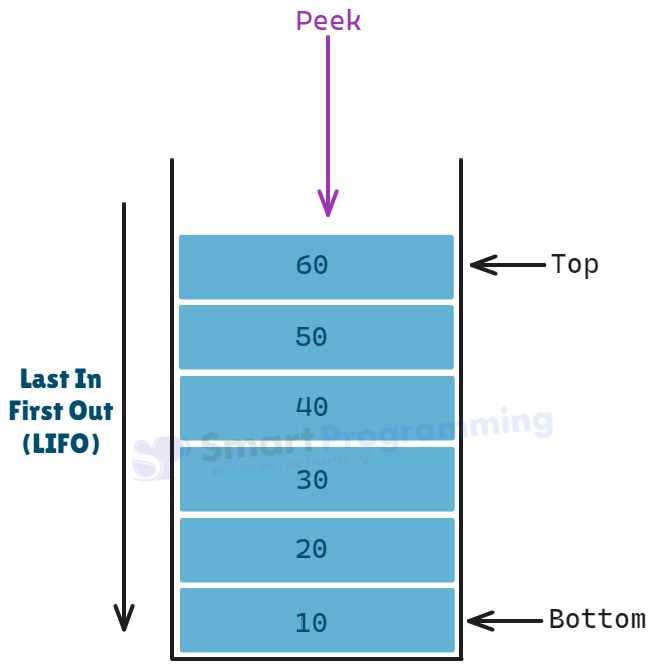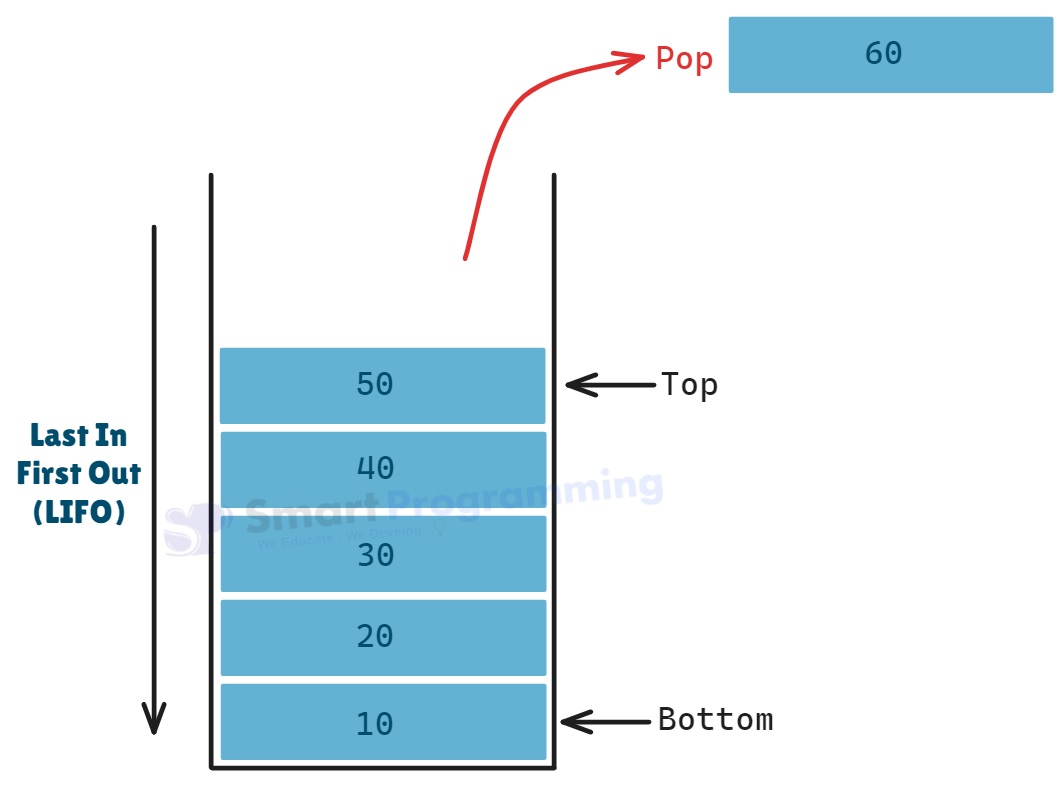Working of Stack in Java
Steps of Working of Stack:
-
Below are the steps of working of
Stackin Java:-
Creation of
Stack:-
A new
Stackcan be created using:
Stack<Integer> stack = new Stack<>(); -
When created, the Stack is empty and its size is
0. -
Internally,
Stackis implemented as a subclass ofVector, which uses a dynamic array to store elements. -
Example internal structure (initially empty):
Top → [ ]
-
A new
-
Pushing Elements onto the
Stack:-
Elements are added using the
push()method:
stack.push(10);
stack.push(20);
stack.push(30);
stack.push(40);
stack.push(50);
stack.push(60);
- Each new element is placed on the top of the stack (Last-In-First-Out principle).

-
Elements are added using the
-
Peeking at the Top Element:
-
The
peek()method returns the top element without removing it.
System.out.println(stack.peek()); // prints 60

-
The
-
Popping Elements from the
Stack:
-
The
pop()method removes and returns the top element of the stack.
int top = stack.pop(); // Removes 60 - After popping, the top shifts to the next element below it.

-
The
-
Searching Elements in the
Stack:-
The
search()method returns position (1-based) of an element from the top of the stack.
System.out.println(stack.search(20)); // returns 4 because 60 has been removed from stack -
If the element is not found, it returns
-1.
-
The
-
Checking if
Stackis Empty:-
The
empty()method checks whether the stack is empty.
System.out.println(stack.empty()); // false
-
The
-
Traversal of
Stack:-
Since Stack extends
Vector, it can be traversed usingIteratoror afor-eachloop. -
Example:
for (Integer no : stack) { System.out.println(no); } - Elements will be printed from bottom to top order.
-
Since Stack extends
-
Creation of
NOTE:
-
All methods of
Stackare synchronized because it extendsVector. -
This makes it thread-safe but slower than modern alternatives like
DequeorArrayDeque. -
Example modern alternative:
Deque<Integer> stack = new ArrayDeque<>(); stack.push(10); stack.push(20); System.out.println(stack.pop());
Stack is Good for:
-
Implementing LIFO (Last-In-First-Out) operations:
-
Stackfollows the LIFO principle — the last element added is the first one removed. - Suitable for use cases like undo/redo operations, expression evaluation, and function call management.
-
-
Thread-safe operations:
-
Since
StackextendsVector, all its methods are synchronized. - Safe for multi-threaded environments where only one thread should modify the stack at a time.
-
Since
-
Simple and quick element management:
-
Provides predefined methods like
push(),pop(),peek(), andsearch()for managing stack elements. - Easy to use for educational purposes or small stack-based operations.
-
Provides predefined methods like
-
Legacy system support:
-
Used in older Java applications before the introduction of
DequeandArrayDeque. - Helpful when maintaining or upgrading legacy Java codebases.
-
Used in older Java applications before the introduction of
Stack is Not Good for:
-
Poor performance in single-threaded environments:
- Synchronization adds unnecessary overhead when thread safety isn’t required.
-
ArrayDequeis much faster for single-threaded stack operations.
-
Limited functionality:
-
The
Stackclass only supports basic stack operations (push, pop, peek, search). -
Does not provide advanced concurrent features like
ConcurrentLinkedDequeorBlockingDeque.
-
The
-
Obsolete compared to modern classes:
-
Considered a legacy class and largely replaced by
DequeorArrayDequesince Java 1.5. - Modern alternatives are faster and more flexible.
-
Considered a legacy class and largely replaced by
-
Sequential search performance:
-
The
search()method performs a linear search (O(n)) starting from the top of the stack. - Inefficient for large stacks where random access is not supported.
-
The
Summary Table:
| Operation | Description | Performance / Complexity |
|---|---|---|
push(E item) |
Adds an element to the top of the stack. | O(1) |
pop() |
Removes and returns the top element. | O(1) |
peek() |
Returns the top element without removing it. | O(1) |
search(Object o) |
Searches the element from top to bottom (1-based index). | O(n) |
empty() |
Checks if the stack is empty. | O(1) |
Traversal |
Can use Iterator or for-each loop. |
O(n) |
Thread Safety |
Yes (inherited synchronized methods from Vector). |
Overhead present |
Help Us Get Better Every Day
Your feedback helps us grow! If there's anything we can fix or improve, please let us know.
We’re here to make our tutorials better based on your thoughts and suggestions.



